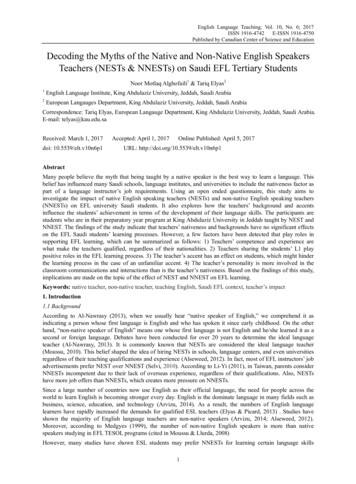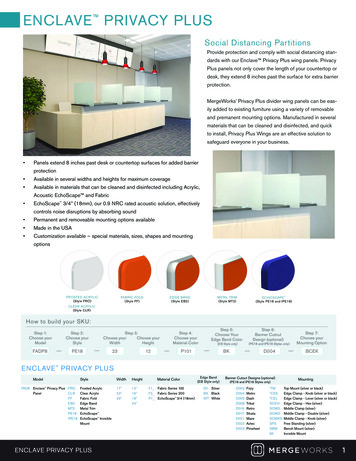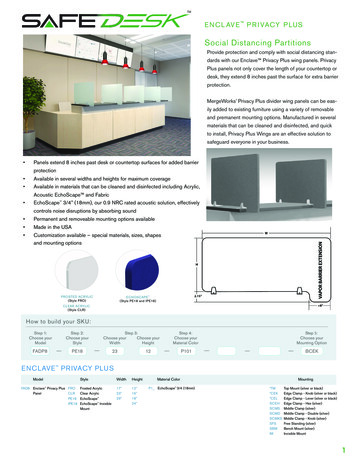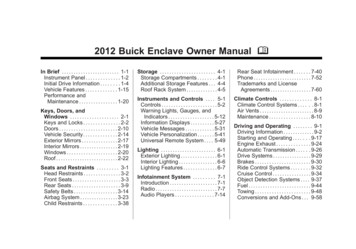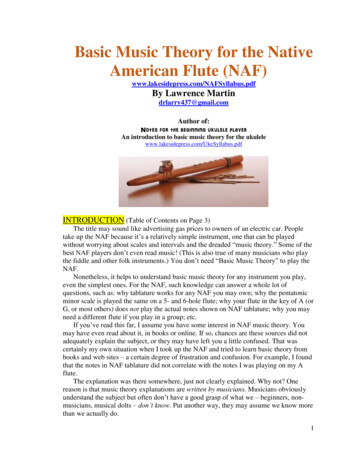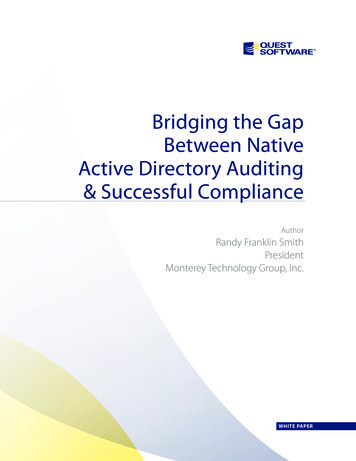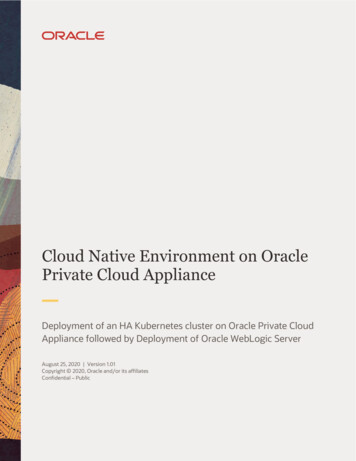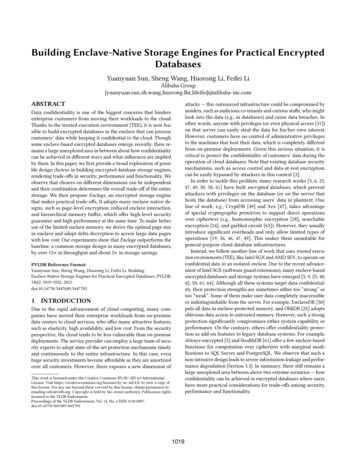
Transcription
Building Enclave-Native Storage Engines for Practical EncryptedDatabasesYuanyuan Sun, Sheng Wang, Huorong Li, Feifei LiAlibaba libaba-inc.comABSTRACTData confidentiality is one of the biggest concerns that hindersenterprise customers from moving their workloads to the cloud.Thanks to the trusted execution environment (TEE), it is now feasible to build encrypted databases in the enclave that can processcustomers’ data while keeping it confidential to the cloud. Thoughsome enclave-based encrypted databases emerge recently, there remains a large unexplored area in between about how confidentialitycan be achieved in different ways and what influences are impliedby them. In this paper, we first provide a broad exploration of possible design choices in building encrypted database storage engines,rendering trade-offs in security, performance and functionality. Weobserve that choices on different dimensions can be independentand their combination determines the overall trade-off of the entirestorage. We then propose Enclage, an encrypted storage enginethat makes practical trade-offs. It adopts many enclave-native designs, such as page-level encryption, reduced enclave interaction,and hierarchical memory buffer, which offer high-level securityguarantee and high performance at the same time. To make betteruse of the limited enclave memory, we derive the optimal page sizein enclave and adopt delta decryption to access large data pageswith low cost. Our experiments show that Enclage outperforms thebaseline, a common storage design in many encrypted databases,by over 13 in throughput and about 5 in storage savings.PVLDB Reference Format:Yuanyuan Sun, Sheng Wang, Huorong Li, Feifei Li. BuildingEnclave-Native Storage Engines for Practical Encrypted Databases. PVLDB,14(6): 1019-1032, 2021.doi:10.14778/3447689.34477051INTRODUCTIONDue to the rapid advancement of cloud computing, many companies have moved their enterprise workloads from on-premisedata centers to cloud services, who offer many attractive features,such as elasticity, high availability, and low cost. From the securityperspective, the cloud tends to be less vulnerable than on-premisedeployments. The service provider can employ a large team of security experts to adopt state-of-the-art protection mechanisms timelyand continuously to the entire infrastructure. In this case, evenhuge security investments become affordable as they are amortizedover all customers. However, there exposes a new dimension ofThis work is licensed under the Creative Commons BY-NC-ND 4.0 InternationalLicense. Visit https://creativecommons.org/licenses/by-nc-nd/4.0/ to view a copy ofthis license. For any use beyond those covered by this license, obtain permission byemailing info@vldb.org. Copyright is held by the owner/author(s). Publication rightslicensed to the VLDB Endowment.Proceedings of the VLDB Endowment, Vol. 14, No. 6 ISSN 2150-8097.doi:10.14778/3447689.34477051019attacks — this outsourced infrastructure could be compromised byinsiders, such as malicious co-tenants and curious staffs, who mightlook into the data (e.g., in databases) and cause data breaches. Inother words, anyone with privileges (or even physical access [31])on that server can easily steal the data for his/her own interest.However, customers have no control of administrative privilegesto the machines that host their data, which is completely differentfrom on-premise deployments. Given this serious situation, it iscritical to protect the confidentiality of customers’ data during theoperation of cloud databases. Note that existing database securitymechanisms, such as access control and data-at-rest encryption,can be easily bypassed by attackers in this context [2].In order to tackle this problem, many research works [5, 6, 25,47, 49, 50, 58, 61] have built encrypted databases, which preventattackers with privileges on the database (or on the server thathosts the database) from accessing users’ data in plaintext. Oneline of work, e.g., CryptDB [49] and Arx [47], takes advantageof special cryptographic primitives to support direct operationsover ciphertext (e.g., homomorphic encryption [28], searchableencryption [54], and garbled circuit [63]). However, they usuallyintroduce significant overheads and only allow limited types ofoperations [19, 36, 46, 47, 49]. This makes them unsuitable forgeneral-purpose cloud database infrastructures.Instead, we follow another line of work that uses trusted execution environments (TEE), like Intel SGX and AMD SEV, to operate onconfidential data in an isolated enclave. Due to the recent advancement of Intel SGX (software guard extensions), many enclave-basedencrypted databases and storage systems have emerged [5, 9, 25, 40,42, 50, 61, 64]. Although all these systems target data confidentiality, their protection strengths are sometimes either too “strong” ortoo “weak”. Some of them make user data completely inaccessibleor indistinguishable from the server. For example, EnclaveDB [50]puts all data in enclave-protected memory, and ObliDB [25] adoptsoblivious data access to untrusted memory. However, such a strongprotection significantly compromises either system capability orperformance. On the contrary, others offer confidentiality protection as add-on features to legacy database systems. For example,Always-encrypted [5] and StealthDB [61] offer a few enclave-basedfunctions for computation over ciphertext with marginal modifications to SQL Server and PostgreSQL. We observe that such anon-intrusive design leads to severe information leakage and performance degradation (Section 3.3). In summary, there still remains alarge unexplored area between above two extreme scenarios — howconfidentiality can be achieved in encrypted databases where usershave more practical considerations for trade-offs among security,performance and functionality.
In this paper, we consider the design of an encrypted storageengine, which is a fundamental building block for full-fledged encrypted databases. Instead of proposing a concrete design directly,we first provide a comprehensive exploration of possible designchoices for encrypted storage engines. These choices achieve different trade-offs among security, performance and functionality,and can be further categorized into five dimensions (i.e., encryptiongranularity, execution logic in enclave, memory access granularity,enclave memory usage, record identity protection) as shown inTable 1. We observe that the decision on each dimension can bemade independently, and their combination determines the overalltrade-off of the entire storage. Moreover, not all combinations areequally useful in practice as we will discuss later. This analysisshould be able to help database practitioners to well understandthe effect of each decision, and guide them to find the best choicesfor their own needs.After exploring the design space, we further make choices oneach dimension, rendering a good trade-off for practical databaseusage. Under this circumstance, we propose Enclage, an enclavenative database storage engine that includes a B -tree-like indexstructure and a heap-file-like table store. It allows data to be securelymaintained in untrusted memory and disk by encrypting individualindex and data pages. This mitigates ciphertext amplifications andprevents information leakage inside a page. To avoid unnecessarycontext switches between enclave and non-enclave executions, wecarefully implement the main execution logic of index (i.e., entrysearch and update) and table (i.e., record read and write) inside theenclave. It is able to reduce the number of enclave entries per requestto one in most cases, and minimize it when external interactions(e.g., I/Os) are required. We further utilize protected memory inenclave to cache frequently accessed pages, relieving the pressure ofencryption/decryption overheads. However, enclave memory spaceis extremely limited, and we have to decide what kind of data andhow much of it should be buffered to achieve the best performance.For example, we find both theoretically and experimentally thatindex pages of 1/2KB size outperforms those 4/8/16KB ones widelyused in existing databases. For data pages, instead of buffering themin enclave, we adopt a delta decryption protocol to support fastrecord access with low enclave memory consumption. Note thatmany of our approaches and optimizations adopted in Enclage arestill applicable even when other design choices are made.Our main contributions are summarized as follows: To the best of our knowledge, we are the first to provide acomprehensive exploration of design choices for buildingenclave-based encrypted database storage. We divide theentire design space into five dimensions and discuss tradeoffs implied by each individual choice. This helps databasepractitioners to find the best design for their own needs. We propose an encrypted storage engine Enclage, renderingpractical design trade-offs. It adopts many enclave-nativedesigns, such as page-level encryption, reduced enclave interaction, and hierarchical memory buffer, which offer highlevel security guarantee, high performance and low storageat the same time. To make better use of the limited enclave memory, we propose several optimizations. A cost model is built to analyzethe optimal index node size (i.e., 1-2KB), which is consistent1020with our experiments. A delta decryption protocol is appliedto access records in data pages efficiently, having no memorycontention against the index. We conduct extensive experiments to evaluate the efficiencyof Enclage, as well as the effectiveness of individual designsadopted by it. Enclage outperforms the baseline, a commonstorage design in existing encrypted databases [5, 61], byover 13 in throughput and about 5 in storage savings.2BACKGROUNDIn this section, we brief the concept of trusted execution environment and Intel SGX, and then discuss the challenges in designingSGX-based encrypted databases.2.1Trusted Execution Environment and SGXA trusted execution environment (TEE) is a secure area, whichguarantees the confidentiality and integrity of computation anddata in it. It can be used to build secure applications in untrustedenvironments (e.g., on a public cloud), where the host may conductmalicious actions. Intel Software Guard Extensions (SGX) is a stateof-the-art implementation of TEE, receiving broad attention fromboth industry and academia. SGX is an extension of x86 instructionset architecture, and it offers protections using a concept calledenclave. Readers can refer to [22, 33, 35] for more details on itsimplementation and features, e.g., isolation, sealing and attestation.An enclave is an isolated virtual address space in a process, whereboth code and data are stored in protected memory pages calledenclave page caches (EPC) that cannot be accessed by the host,i.e., the rest of the process outside the enclave. The data in EPCis encrypted by a memory encryption engine (MEE), which onlydecrypts data in the CPU cache. The host can only initialize theenclave by loading a specially compiled library (e.g., *.signed.sowhose authenticity can be verified), and later interact with the enclave via well-defined functions (i.e., ECall/OCall). Note that theenclave can access the entire address space of the process, whilethe host cannot access enclave’s memory. This is an importantproperty that can be exploited for fast data fetching, comparedto co-processor TEE implementations (e.g., FPGA) where memoryaccess has to go through PCIe. SGX provides remote attestation thatallows the client to verify the authenticity of an enclave and itsloaded code/data on a remote host. It facilitates the establishmentof a secure channel between the client and the enclave (e.g., topass secret keys). Note that AMD SEV [4, 38, 39] is a promisingalternative to SGX to ensure the confidentiality of user data hostedby an untrusted server, but currently lacking of integrity protection [39, 53] and security-proven remote attestation [17]. The latteris a necessity for secure key provision to encrypted databases onthe cloud.2.2Challenges for SGX-based DatabasesSGX provides essential primitives for building encrypted databases.However, there remain many critical challenges to achieve a robustand performant design. They are attributed to both the nature ofTEE techniques and the limitations from SGX implementation.Limited memory space in enclave. Due to hardware limitations for securing the memory, the preserved memory region islimited to 128MB [8, 9, 45] (or 256MB in the latest implementation)
and the actual EPC capacity is even slightly lower. Furthermore,this capacity is shared by all enclaves running on that processor.To hide this limitation, SGX provides a virtual memory abstractionto evict recently unused EPC pages to the host memory. To ensure confidentiality and integrity, evicted pages are encrypted andstored in a Merkle Tree [27, 56]. An EPC fault (i.e., loading a pageback) will cause significant penalty [8, 22], easily exceeding 40000CPU cycles. In databases, many components (e.g., buffer pool) andoperations (e.g., join) are inherently memory-consuming, whichshould be carefully re-designed. For example, a naive adaptation ofindexes in enclave memory could underperform by three orders ofmagnitude [9].Huge cost from enclave interaction. The host process canonly invoke enclave via pre-defined function calls (ECall). Since anenclave runs in user mode (ring 3), it cannot execute system calls,which instead requires to temporally exit the enclave (OCall). Thecost of ECall/OCall is expensive, i.e., about 8000 cycles as previously reported [45, 62]. Due to recent patches on SGX driver andmicrocode, we observe that this cost reaches 15000 cycles. SGX nowsupports a switchless mode for relatively efficient (asynchronous)calls [34, 57]. Nevertheless, frequent context switches between theenclave and host must be prevented. This raises a challenge toexisting database kernels that are unaware of this issue.Dilemma of TCB size. The size of trusted computing base(TCB) is always a issue in TEEs. In the context of SGX, it includesthe processor, microcode and loaded library. Any vulnerabilitiesin the loaded code will compromise the security of the entire system. Hence, reducing TCB size (i.e., codebase size) makes it morerobust, where an exhaustive examination of codebase becomes feasible. However, this inherently leads to frequent context switchesbetween enclave and host (degrading performance as discussedabove), and leaves most of the execution logic unprotected (suffering from leakage-abuse attacks [18, 29]). Enlarging the TCBsize resolves these issues. However, importing complex databasefunctionality into the enclave inherits all vulnerabilities from theoriginal codebase. It results in a cumbersome patching process andmakes TCB less reusable by different database implementations.Hence, the choice of TCB size is extremely critical.33.1.2 Encrypted Storage Abstraction. Without the loss of generality, we use a simple case to demonstrate functions that should besupported by an encrypted storage engine. Assume there is a singletable T with n columns {C 0, C 1, ., Cn 1 }, where PK C 0 and isindexed. We denote a record r as [E(k), E(v 1 ), ., E(vn 1 )], wherek, vi , are values for C 0 , Ci , respectively. To ensure confidentiality,data involved in all storage operations must be ciphertext:Put(r ): insert a row to T if its key k does not exist.Get(E(k)) r : get the row from T given a key k.Update(r ): update the row from T given a key k.Delete(E(k)): delete the row from T given a key k.RangeScan(E(k 1 ),E(k 2 )) {r i , ., r j }: retrieve all rowsfrom T whose keys are between k 1 and k 2 . FullScan() {r 1, r 2, ., rm }: retrieve all rows from T . Note that retrievals on non-key columns are also supported. Wecan either conduct a FullScan to exact qualified records or buildsecondary indexes on them.3.1.3 Index and Table Store. We consider the storage architecturethat consists of a B -tree [24] index and a heap-file table store. Datain both the index and table store is organized as many index ordata pages (e.g., of 4KB size). A new record is first appended tothe heap file of the table store, and is assigned a record identifier(rid for short). The rid can be used to retrieve the correspondingrecord from the table store. An index stores a pair of index key(i.e., value in the indexed column) and rid for each record. In thiscase, indexes on both primary-key column and non-key columnsare unclustered. Some sophisticated databases, such as PostgreSQL,follow similar settings. Note that rids passed between indexes andtable store might be either ciphertext or plaintext, which affects theinformation leakage inside the database. We denote an optionallyencrypted rid as OE(rid), which is either rid or E(rid). To supportstorage operations above, the table store T S has to support: ENCLAVE-BASED ENCRYPTED STORAGEIn this section, we first define our data model and threat model, andthen introduce a strawman design [5, 61] as a stepping stone to thesubsequent design space exploration. At last, we discuss differentdesign choices categorized into five dimensions.3.1preferred, e.g., AES CBC/GCM modes. Columns can be encryptedby different DEKs to further strengthen the security. Note that it isfeasible to have plaintext columns, but this may cause unexpectedinformation leakage from cross-column correlations [6, 13].TPut(r ) OE(rid): insert a row to T S.TGet(OE(rid)) r : get the row from T S given a rid.TUpdate(OE(rid),r ): update the row from T S given a rid.TDelete(OE(rid)): delete the row from T S given a rid.TFullScan() {r 1, r 2, ., rm }: retrieve all rows from T S.The primary index PI has to support:Data Model and Abstraction3.1.1 Data model. We consider a relational data model, where a table T contains n columns (i.e., attributes) COL {C 0, C 1, ., Cn 1 }and has a primary key PK COL. Data in all columns are considered confidential, such that each value must be encrypted usinga data encryption key (DEK) before the value can be sent to thedatabase. This DEK will be later provisioned to the enclave whencomputation over plaintext is needed. For a record (i.e., a row) r , itsvalue vi stored in column Ci is the ciphertext E(vi ), where E(x)represents the encryption scheme used by the data owner. To ensure high-level security guarantee, encryption schemes that provideindistinguishability under chosen-plaintext attack (IND-CPA) are1021 IInsert(E(k),OE(rid)): insert an entry with key k to PI .ISearch(E(k)) OE(rid): search the entry with key k.IReplace(E(k),OE(rid)): replace the entry with key k.IRemove(E(k)): remove the entry from PI with key k.IRangeSearch(E(k 1 ),E(k 2 )) {ridi , ., rid j }: search allentries from PI whose keys are between k 1 and k 2 .The secondary index is similar and we omit its functions here. Wefollow the separation of table store and unclustered indexes, becauseit enables the discussion of more design choices (Section 3.4). Italready covers the case for clustered indexes, i.e., we can replacerids with records in the primary index and have primary key’sciphertext in secondary indexes.
3.2Threat Model3.3P629CiphertextOur major goal is to ensure the confidentiality of user data hostedby an untrusted database server. Similar to [5], we target a strongadversary with privileged access to OS and database, who can notonly monitor the content of all server’s memory, disk and communication, but also actively tamper with it (e.g., attaching a debugger todatabase). However, the adversary cannot access enclaves providedby SGX (or any TEE with capabilities similar to SGX). In particular,data and computation inside an enclave are protected with respectto the confidentiality and integrity. The communication betweenenclave and host (e.g., ECall/OCall, direct access to host memoryinsi
Building Enclave-Native Storage Engines for Practical Encrypted Databases Yuanyuan Sun, Sheng Wang, Huorong Li, Feifei Li Alibaba Group a-inc.com ABSTRACT Data condentiality is one of the biggest concerns that hinders enterprise customers from moving their workloads to the cloud.Author: Yuanyuan Sun, Sheng Wang, Huorong Li, Feifei LiPublish Year: 2021
